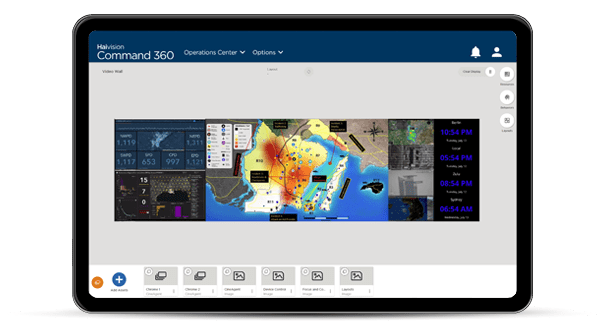As visual collaboration platforms grow more sophisticated, manufacturers combine both traditional and innovative hardware and software components to meet customer requirements. While incorporating a variety of options in a video wall system’s design provides flexibility, it also exposes system users to potential security risks. The risk is especially high if the materials are procured from unreliable sources.
To mitigate vulnerabilities, the Pentagon and intelligence agencies have levied a host of new supply chain risk management guidelines. This is the inevitable consequence of global supply chains, ever growing cyber threats, and recognition of how much of the defense community’s intellectual propriety resides in the supplier network. Commercial companies are concerned about the financial impact threats like cyber espionage and counterfeit manufacturing pose. U.S. government agencies, on the other hand, must consider how technical vulnerabilities threaten human life. Video wall systems offering supply chain-controlled components help mitigate security risks.
Now more than ever, enhanced data security is of paramount necessity for U.S. government agencies and many commercial enterprises. Security starts at the hardware manufacturing level. When investing in large-scale technology, such as a visual collaboration system, seek providers who deliver supply chain-controlled solutions. The most reliable supplier controls all aspects of the system, from manufacturing to design, installation, integration, and ongoing support. This strategy not only ensures cohesive implementation of the system, but also strict control of component sourcing and reduced risk.
In today’s world, organizations need documented proof that they purchased hardware and software products designed, procured, and manufactured according to TAA compliance guidelines. Products must also meet guidance in FAR 52.204-23 Prohibition on Contracting for Hardware, Software, and Services Developed or Provided by Kaspersky Lab and Other Covered Entities (Jul 2018) and FAR 52.204-25 Prohibition on Contracting for Certain Telecommunications and Video Surveillance Services or Equipment (Aug 2019).
What is TAA Compliance?
The Trade Agreements Act (TAA) (19 U.S.C. & 2501-2581) of 1979 was enacted to foster fair and open international trade, but more importantly, it mandated the United States government may acquire only U.S.-made or -designated end products. Reciprocal trade agreements enable trade between the U.S. and countries compliant with the intent and guidance of the TAA.
Four types of designated countries have reciprocal trade agreements with the U.S.:
- Free Trade Agreement countries, including Canada, Mexico, and Australia
- Countries participating in the World Trade Organization’s Government Procurement agreement, including Japan and many European countries
- Caribbean Basin countries, such as Costa Rica, Haiti and Jamaica
- Countries designated as “least developed,” such as Afghanistan, Bangladesh, Laos and Ethiopia
Non-TAA countries include the People’s Republic of China, Iran, North Korea, Pakistan, Sri Lanka, Russia, Cuba, and India. This often presents a significant issue for some electronics manufacturers due to the pervasive distribution of non-compliant products through countless unknown channels.
Haivision Supply Chain-Controlled Products
Haivision understands the importance of TAA compliance. We offer supply chain-controlled video wall products to meet this critical requirement. By controlling all aspects of the end-product design, parts procurement, and manufacturing, Haivision ensures prohibited suppliers and components are not used in our video wall products in compliance with the latest supply chain risk management and TAA regulations.
Teams in every branch of the U.S. Armed Forces and nearly every major federal entity – from the FBI to NASA – trust Haivision systems to support their 24/7, mission-critical operations. Our systems have been tested and proven in the world’s most demanding environments. Our CineNet software platform and lineup of video processors, encoders/decoders, expanders, and expeditionary systems are built in the U.S. In addition, Haivision partners offer documented supply chain-controlled LED and LCD video wall displays in a full range of sizes to meet each customer’s unique specifications.
If you’d like to discuss how our products can meet your organization’s supply chain-controlled risk management needs, contact Haivision MCS to schedule a demo.
